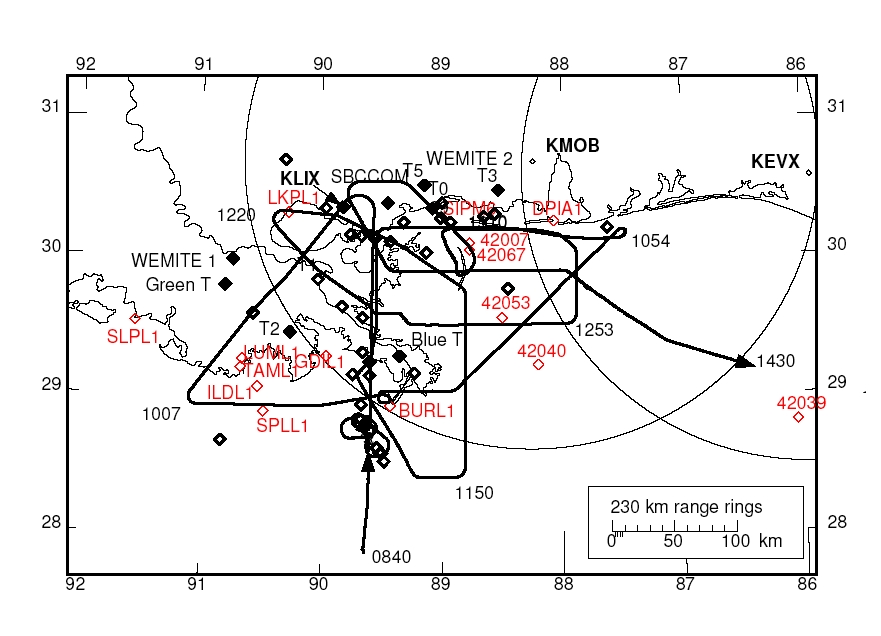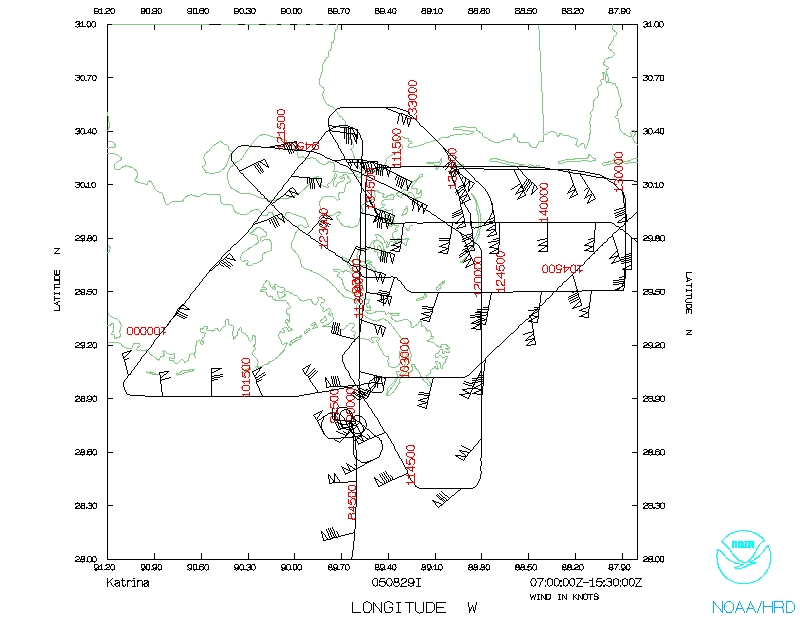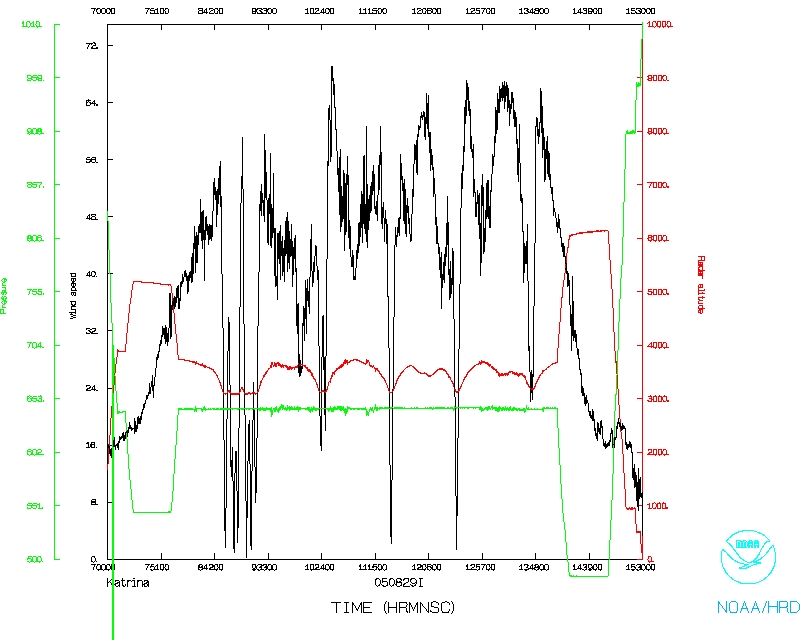
Figure 1. Flight track of NOAA 43.
| Mike Black | LPS |
| Peter Dodge | LPS/Radar |
| Chris Landsea | Dropsonde |
| Stan Goldenberg | AXBT
Dropsonde |
| CAPT Phil Kennedy CDR Randy Tebeest LT Mark Nelson |
Pilots |
| Tom Shepherd | Flight Director |
| LT Devin Brakob | Navigator |
| Greg Bast | Flight Engineers |
| Sean McMillan Mark Rogers John Hill | Electronics |
| CAPT Steve Kozak | Observer |
Mission Plan :
As Category 5 Hurricane Katrina headed for the Mississippi Delta a decision was made to add a NOAA research flight to cover the landfall. 42's flight crew would use NOAA 43 to make this last NOAA flight into the storm. Teams from Texas Tech University, the Florida Coastal Monitoring Program and the University of Louisiane at Monroe had deployed several portable wind towers, concentrating on the east side of the expected landfall point, from Slidell, Louisiana, to Biloxi, Mississippi. A flight plan was devloped that included high density sonde and AXBT drops in the eyewall for Joe Cione's surface flux study, runs along the coast to collect data in support of the tower teams and passes inland if possible to gather data in support of John Kaplan's inland decay research. High density drop sequences were planned during coastal runs to address Mark Powell's hypothesis that shoaling waves could change the reduction factor used to adjust flight-level winds to 10 m, 1 min windspeeds.

Figure 1. Flight track of NOAA 43.
Mission Summary :
NOAA 43 took off from MacDill at 0654 UTC, 29 August. We reached our IP at 0840 UTC (Figure 1). An image from the Slidell WSR-88D at 0859 UTC (Figure 2) shows that the eyewall had opened up on the southern half, while a massive rain shield covered the coast North of the eye. We dropped the first sequence of sondes and BTs in the southern eyewall at 0848. The sonde data came in quite late so we circled for a while in the eye while the techs diagnosed the problem. We flew through the center at 0921 and proceeded N to overfly the Slidell WSR-88D. Then a SW track took us over Lake Ponchartrain and then over the Delta. We turned near Grand Isle to make a West-East pass through the center at 1023 when the center of Katrina was just crossing the coast near the C Man Site at Buras (BURL1).

After passing through the eastern eyewall, 43 turned to the NE and flew up to the coast near Pensacola. At 1054 we turned W and flew along the coast until we were N of the center. We turned and passed through the center again at 1131. From there 43 continued S and then SE and E until 1150 when we turned to head back N; the goal was to collect more SFMR data in the onshore flow as well as to set up for a sonde seguence paralleling the wind flow at the coast, which we accomplished at 1208-1210. 43 continued NW to site LKPL1 at the NW end of Lake Ponchatrain.
We turned SE and headed back for the center, which we hit at 1232. From the center we proceeded E past buoy 42053. When due S of Mobile we turned N to the coast back W. We did a loop around Chandeleur Island while sondes were prepared for a final along wind sequence in the wind max. 4 sondes were deployed at 1325-1327 upwind of the WEMITE and T0 and T5 towers at Stennis International Airport and Gulfport. We turned and headed W to KLIX. From there we headed back to the center, where we hit a bird at 1345, after which we turned E, passed through the E eyewall, where we made our last drop at 1350 and headed back to Florida. Figure 3 shows KLIX reflectivity at 1354, the last sweep transmitted by the 88d (although the radar did continue to operate). The aircraft landed back at MacDill at 1530 UTC.

Evaluation :
The data collected on this flight should help in evaluating the surface windfields at landfall. 36 sondes were dropped on this flight. The highest sfc wind from the sondes was 100 kt near Boothville on the first landfall. The winds seemed lower on the second landfall, on the order of 95 kt (from the sondes). We most likely did not sample the highest winds with the sondes. The striking observation from the flight was that high sfc winds of 85-100 kt extended far east of the center, no doubt contributing to the extensive surge that occurred. We feel that the winds were lower than the central pressure suggested because the pressure gradient had flattened considerably. The highest flight- level (12,500 ft) winds of about 125 kt were found between the inner and outer eyewalls (moat region) on the east side of the storm.
The SFMR readings were very stable during the flight, matched well with the dropsonde data, and tracked almost exactly together with the other, non- transmitting SFMR. It was interesting that the SFMR worked and was giving what appeared to be accurate readings over portions of the delta, undoubtedly because this area was under water. The SFMR also worked well while over Lake Ponchartrain, verified by a sonde we dropped there.
Expendables :
We used 36 GPS sondes and 4 AXBT's.
Acknowledgments :
Once again a landfall flight required flexibility and attention to detail that Capt. Kennedy, Tom Shepherd and the rest of the AOC flight and scientific crew provided. This flight was added on at the last moment and we appreciate AOC for once more allowing us to collect data in a hurricane at landfall. AOC contributed the flight hours and the UBLOX sondes. Thanks also to John Kaplan and Mark Powell for providing the FCMP tower positions and guidance in flight planning, and to Sim Aberson and Steve Feuer for ground support.
Problems :
All of the sondes were the new UBLOX sondes. The real-time AVAPS software could not handle 4 sondes in the air at once, but these data will be recovered in post-processing at NCAR.
Peter Dodge
Co-LPS
| Latitude | Longitude | Portable Tower |
| 29 47' 1.68" | 90 48' 15.7" | Tower 3 - Green Tower Nicholls State University in Thibodaux, LA |
| 29 58.08' | 90 44.56' | WEMITE 1 Vacherie, LA |
| 29 26' 38.8" | 90 15' 45.9" | T2 LaFourche Airport, Galliano, LA |
| 29 49' 31" | 90 01' 55" | T1 Belle Chasse Naval Air Station, Belle Chasse, LA |
| 30 20.53' | 89 49.32' | SBCCOM (1) Slidell Municipal Airport, Slidell, LA |
| 30 22.45' | 89 27.05' | WEMITE 2 SBCCOM (2) Stennis International Airport, Bay St. Louis, MS |
| 30 22' 48.3" | 89 27' 18.5" | T0 Stennis International Airport, Bay St Louis, MS |
| 29 16' 21.72" | 89 21' 11.45 | Tower 2 - Blue Tower Gulf side levee @ Buras, LA |
| 30 30' 31" | 89 08' 48" | T5 ShadeTree Airfield, Gulfport, MS |
| 30 28'19.2" | 88 31' 51" | T3 Trent Lott Airfield, Pascagoula, MS |
| # | Sonde ID | Launch | Splash UTC | Comments | ||
| UTC | Lat | Lon | ||||
| 1 | 051946009 | 0848 | 28.51 | 89.48 | 0852 | WL150 22094 085 DLM WND 22100 932902 MBL WND 22603 EYEWALL 180 |
| 2 | 051946012 | 0848 | 28.57 | 89.50 | 0853 | WL150 21597 085 MBL WND 22606 EYEWALL 180 |
| 3 | 051946006 | 0849 | 28.57 | 89.51 | 0853 | WL150 22588 085 MBL WND 23594 EYEWALL 180 |
| 4 | 051946011 | 0849 | 28.61 | 89.54 | 0853 | EYEWALL 180 |
| 5 | 053116227 | 0912 | 28.80 | 89.62 | 0916 | WL150 25512 085 DLM WND 28509 916644 MBL WND 26011 EYE |
| 6 | 051946010 | 0925 | 29.13 | 89.60 | 0925 | WL150 06099 085 DLM WND 06101 935909 MBL WND 06102 EYEWALL 000 |
| 8 | 051926143 | 0925 | 29.14 | 89.74 | 0930 | WL150 07096 085 DLM WND 07106 940903 MBL WND 07109 EYEWALL 000 |
| 9 | 051946013 | 0926 | 29.23 | 89.60 | 0926 | DLM WND 08617 876828 EYEWALL 000 |
| 10 | 051926149 | 0944 | 30.34 | 89.97 | 0949 | DLM WND 08085 941700 LST WND 405 RAINBAND |
| 11 | 044535109 | 0955 | 29.58 | 90.57 | 0959 | WL150 35069 085 DLM WND 03580 968645 MBL WND 36077 RAINBAND |
| 12 | 051946005 | 1014 | 28.66 | 90.83 | 1022 | DLM WND 35105 898697 RAINBAND |
| 13 | 051926021 | 1021 | 28.92 | 89.67 | 1025 | WL150 26568 085 DLM WND 29570 925651 MBL WND 27572 EYEWALL 270 |
| 14 | 051926082 | 1030 | 29.15 | 89.23 | 1034 | WL150 14608 085 DLM WND 17616 935642 MBL WND 15624 EYEWALL 090 |
| 16 | 044535102 | 1042 | 29.76 | 88.45 | 1047 | WL150 12577 086 DLM WND 15105 981640 MBL WND 13088 LST WND 011 |
| 17 | 051926103 | 1057 | 30.20 | 87.62 | 1101 | RAINBAND |
| 18 | 051946026 | 1107 | 30.28 | 88.65 | 1112 | WL150 09574 089 DLM WND 12598 983644 MBL WND 10086 LST WND 014 |
| 19 | 051926110 | 1113 | 30.24 | 89.32 | 1118 | WL150 09086 090 DLM WND 10603 975641 MBL WND 09094 LST WND 015 |
| 20 | 051946036 | 1117 | 30.14 | 89.67 | 1121 | WL150 07090 111 DLM WND 09601 968653 MBL WND 07097 LST WND 036 |
| 21 | 051926201 | 1126 | 29.30 | 89.66 | 1131 | WL150 06596 094 MBL WND 07105 LST WND 019 |
| 22 | 051926114 | 1127 | 29.55 | 89.66 | 1131 | WL150 06080 089 DLM WND 09084 931647 MBL WND 07097 LST WND 014 |
| 23 | 051926111 | 1208 | 30.12 | 89.56 | 1213 | WL150 07105 092 DLM WND 10112 960644 MBL WND 08107 LST WND 017 |
| 24 | 051946058 | 1209 | 30.10 | 89.43 | 1213 | DLM WND 09612 856648 |
| 25 | 051946004 | 1210 | 30.15 | 89.76 | 1215 | WL150 05579 087 DLM WND 08103 962653 MBL WND 06092 LST WND 012 |
| 26 | 053116086 | 1222 | 30.69 | 90.31 | 1226 | WL150 00576 085 DLM WND 04085 969650 MBL WND 00581 |
| 27 | 053116226 | 1230 | 29.63 | 89.83 | 1234 | WL150 00580 087 DLM WND 03072 929645 MBL WND 01593 LST WND 012 |
| 28 | 051946001 | 1242 | not processed? | |||
| 29 | 053116061 | 1306 | 30.30 | 88.56 | 1311 | DLM WND 15110 951647 MBL WND 14115 LST WND 242 |
| 30 | 053116094 | 1313 | no winds | |||
| 31 | 053116062 | 1325 | 30.24 | 88.93 | 1329 | WL150 12602 085 DLM WND 14616 966648 MBL WND 12608 |
| 32 | 051926016 | 1326 | 30.27 | 89.01 | 1330 | WL150 12091 085 DLM WND 13610 965651 MBL WND 12103 |
| 33 | 053116233 | 1327 | 30.34 | 89.08 | 1330 | WL150 12106 085 DLM WND 13621 964643 MBL WND 12119 |
| 34 | 053116068 | 1327 | bad sonde | |||
| 35 | 051926022 | 1340 | 30.15 | 89.76 | 1345 | WL150 04087 087 DLM WND 07590 939643 MBL WND 05100 LST WND 012 EYEWALL 000 |
| 36 | 044535124 | 1350 | 30.02 | 89.13 | 1354 | WL150 15110 085 DLM WND 17112 948652 MBL WND 15610 EYEWALL 090 |
Mission Data
Flight Data | ||
 Flight track |
 Temperature and Moisture |
 Wind and Atlitude |
Page last updated October 19, 2006
Return to Mission page.